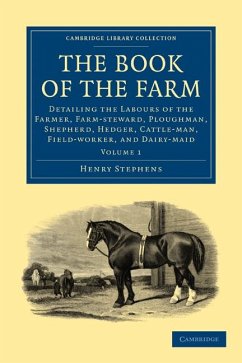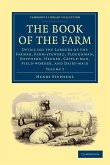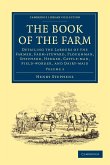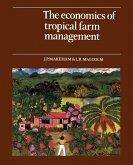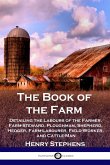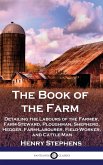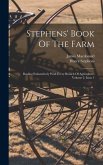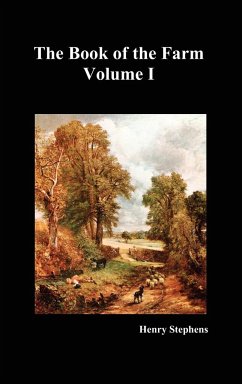Henry Stephens
The Book of the Farm - Volume 1
Henry Stephens
The Book of the Farm - Volume 1
- Broschiertes Buch
- Merkliste
- Auf die Merkliste
- Bewerten Bewerten
- Teilen
- Produkt teilen
- Produkterinnerung
- Produkterinnerung
A detailed description and guide to best contemporary farming practice, including agriculture, dairying and livestock farming, first published in 1842.
Andere Kunden interessierten sich auch für
![The Book of the Farm - Volume 2 The Book of the Farm - Volume 2]() Henry StephensThe Book of the Farm - Volume 269,99 €
Henry StephensThe Book of the Farm - Volume 269,99 €![The Book of the Farm - Volume 3 The Book of the Farm - Volume 3]() Henry StephensThe Book of the Farm - Volume 369,99 €
Henry StephensThe Book of the Farm - Volume 369,99 €![The Economics of Tropical Farm Management The Economics of Tropical Farm Management]() J. P. MakehamThe Economics of Tropical Farm Management69,99 €
J. P. MakehamThe Economics of Tropical Farm Management69,99 €![The Book of the Farm The Book of the Farm]() Henry StephensThe Book of the Farm17,99 €
Henry StephensThe Book of the Farm17,99 €![The Book of the Farm The Book of the Farm]() Henry StephensThe Book of the Farm27,99 €
Henry StephensThe Book of the Farm27,99 €![Stephens' Book Of The Farm: Dealing Exhaustively With Every Branch Of Agriculture, Volume 2, Issue 1 Stephens' Book Of The Farm: Dealing Exhaustively With Every Branch Of Agriculture, Volume 2, Issue 1]() Henry StephensStephens' Book Of The Farm: Dealing Exhaustively With Every Branch Of Agriculture, Volume 2, Issue 134,99 €
Henry StephensStephens' Book Of The Farm: Dealing Exhaustively With Every Branch Of Agriculture, Volume 2, Issue 134,99 €![The Book of the Farm. Volume I. (Hardcover) The Book of the Farm. Volume I. (Hardcover)]() Henry StephensThe Book of the Farm. Volume I. (Hardcover)35,99 €
Henry StephensThe Book of the Farm. Volume I. (Hardcover)35,99 €-
-
-
A detailed description and guide to best contemporary farming practice, including agriculture, dairying and livestock farming, first published in 1842.
Hinweis: Dieser Artikel kann nur an eine deutsche Lieferadresse ausgeliefert werden.
Hinweis: Dieser Artikel kann nur an eine deutsche Lieferadresse ausgeliefert werden.
Produktdetails
- Produktdetails
- Verlag: Cambridge University Press
- Seitenzahl: 710
- Erscheinungstermin: 1. November 2010
- Englisch
- Abmessung: 229mm x 152mm x 42mm
- Gewicht: 1134g
- ISBN-13: 9781108024945
- ISBN-10: 1108024947
- Artikelnr.: 32881817
- Herstellerkennzeichnung
- Libri GmbH
- Europaallee 1
- 36244 Bad Hersfeld
- gpsr@libri.de
- Verlag: Cambridge University Press
- Seitenzahl: 710
- Erscheinungstermin: 1. November 2010
- Englisch
- Abmessung: 229mm x 152mm x 42mm
- Gewicht: 1134g
- ISBN-13: 9781108024945
- ISBN-10: 1108024947
- Artikelnr.: 32881817
- Herstellerkennzeichnung
- Libri GmbH
- Europaallee 1
- 36244 Bad Hersfeld
- gpsr@libri.de
1. The difficulties which the young farmer has to encounter at the outset of learning practical husbandry
2. The means of overcoming those difficulties
3. The kind of information to be found in existent works on agriculture
4. The construction of 'The Book of the Farm'
5. The existing methods of learning practical husbandry
6. The establishment of scientific institutions of practical agriculture
7. The evils attendant on landowners neglecting to learn practical agriculture
8. Experimental farms as places for instruction in farming
9. A few words to young farmers who intend emigrating as agricultural settlers to the colonies
10. The kind of education best suited to young farmers
11. The different kinds of farming
12. Choosing the kind of farming
13. Selecting a tutor farmer for teaching farming
14. The pupilage
15. Dealing with the details of farming
Part I. Winter: 16. The steading or farmstead
17. The farm-house
18. The persons who labour the farm
19. The weather in winter
20. Climate
21. Observing and recording facts
22. Soils and subsoils
23. Enclosures and shelter
24. The planting of thorn hedges
25. The plough
26. The various modes of ploughing ridges
27. Draining
28. Yoking and harnessing the plough, and of swing-trees
29. Ploughing stubble and lea-ground
30. Trench and subsoil ploughing, and moor-band pan.
2. The means of overcoming those difficulties
3. The kind of information to be found in existent works on agriculture
4. The construction of 'The Book of the Farm'
5. The existing methods of learning practical husbandry
6. The establishment of scientific institutions of practical agriculture
7. The evils attendant on landowners neglecting to learn practical agriculture
8. Experimental farms as places for instruction in farming
9. A few words to young farmers who intend emigrating as agricultural settlers to the colonies
10. The kind of education best suited to young farmers
11. The different kinds of farming
12. Choosing the kind of farming
13. Selecting a tutor farmer for teaching farming
14. The pupilage
15. Dealing with the details of farming
Part I. Winter: 16. The steading or farmstead
17. The farm-house
18. The persons who labour the farm
19. The weather in winter
20. Climate
21. Observing and recording facts
22. Soils and subsoils
23. Enclosures and shelter
24. The planting of thorn hedges
25. The plough
26. The various modes of ploughing ridges
27. Draining
28. Yoking and harnessing the plough, and of swing-trees
29. Ploughing stubble and lea-ground
30. Trench and subsoil ploughing, and moor-band pan.
1. The difficulties which the young farmer has to encounter at the outset of learning practical husbandry
2. The means of overcoming those difficulties
3. The kind of information to be found in existent works on agriculture
4. The construction of 'The Book of the Farm'
5. The existing methods of learning practical husbandry
6. The establishment of scientific institutions of practical agriculture
7. The evils attendant on landowners neglecting to learn practical agriculture
8. Experimental farms as places for instruction in farming
9. A few words to young farmers who intend emigrating as agricultural settlers to the colonies
10. The kind of education best suited to young farmers
11. The different kinds of farming
12. Choosing the kind of farming
13. Selecting a tutor farmer for teaching farming
14. The pupilage
15. Dealing with the details of farming
Part I. Winter: 16. The steading or farmstead
17. The farm-house
18. The persons who labour the farm
19. The weather in winter
20. Climate
21. Observing and recording facts
22. Soils and subsoils
23. Enclosures and shelter
24. The planting of thorn hedges
25. The plough
26. The various modes of ploughing ridges
27. Draining
28. Yoking and harnessing the plough, and of swing-trees
29. Ploughing stubble and lea-ground
30. Trench and subsoil ploughing, and moor-band pan.
2. The means of overcoming those difficulties
3. The kind of information to be found in existent works on agriculture
4. The construction of 'The Book of the Farm'
5. The existing methods of learning practical husbandry
6. The establishment of scientific institutions of practical agriculture
7. The evils attendant on landowners neglecting to learn practical agriculture
8. Experimental farms as places for instruction in farming
9. A few words to young farmers who intend emigrating as agricultural settlers to the colonies
10. The kind of education best suited to young farmers
11. The different kinds of farming
12. Choosing the kind of farming
13. Selecting a tutor farmer for teaching farming
14. The pupilage
15. Dealing with the details of farming
Part I. Winter: 16. The steading or farmstead
17. The farm-house
18. The persons who labour the farm
19. The weather in winter
20. Climate
21. Observing and recording facts
22. Soils and subsoils
23. Enclosures and shelter
24. The planting of thorn hedges
25. The plough
26. The various modes of ploughing ridges
27. Draining
28. Yoking and harnessing the plough, and of swing-trees
29. Ploughing stubble and lea-ground
30. Trench and subsoil ploughing, and moor-band pan.

